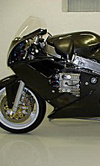A typical example of evolution of 'unusual' pushrod systems
 When thinking of a topic about 'pushrods', one might think on the specifics of the pushrod as a component. Another is to think of the way valvetrain systems have developed over time, from the low in-block camshaft and pushrod-actuated side valve systems to the current four double-overhead camshaft systems, and everything in between.
When thinking of a topic about 'pushrods', one might think on the specifics of the pushrod as a component. Another is to think of the way valvetrain systems have developed over time, from the low in-block camshaft and pushrod-actuated side valve systems to the current four double-overhead camshaft systems, and everything in between.
Looking for a typical example of such an evolution, my interest was awakened in the BMW approach with its boxer motorcycle valvetrain systems, where clear progress can be seen from very basic valvetrain systems to the current finger-follower systems. This development connects motorcycle and car technology, originating from motorsports initiatives.
In the past, BMW boxer motorcycles have had their engines transverse to the driving direction, to improve air cooling of the cylinders. The consequence is the wider overall width of the engine, leading to lean angle constraints in motorcycle racing. To reduce width as much as possible, BMW has introduced two major updates of the valvetrain mechanism over the past 20 years or so - the R259 series in 1993, with the Hi Camshaft valvetrain mechanism, still using pushrods and, in 2008, the HP2 models, with overhead camshafts and finger followers.
Before 1993, BMW had developed its boxer models with a low, in-block camshaft centrally located below the crankshaft, flat cam followers and 'long' pushrods, actuating rockers and valves. Issues such as floating valves were common when increasing rpm for higher output for specific race applications. All kinds of solutions were explored to improve the system at the time, by optimising the mass of the system and using spring-backed cam followers.
From 1993 a totally new boxer engine was introduced, which was equipped with a so-called high camshaft position. In the past, a number of engines were equipped with high-mounted camshafts, most of them still located in the engine block, for ease of manufacturing. In this new design though, a separate bracket on the cylinder head incorporates the camshaft, a set of cam followers (bucket type) and the valve rockers, the latter two components connected through two short pushrods made from aluminium with hardened rod ends.
During the R259's development, BMW also undertook some studies in parallel, which included a study with desmodromic valve actuation on the so-called BMW R1, all to investigate ways to decrease the overall width of the engine.
After the introduction of this new boxer engine, the top end was gradually optimised for higher rpm durability, reducing valve-sided mass by decreasing valve stem and head, required for the higher revving R1100S engine. Mainly due to the fact that the BMW boxer engine would never be a real race engine, apart from appearances in the Dakar rally, the 24h of Le Mans and the Boxer Cup, no further specific race engineering on a professional level was done on the engine to improve performance significantly.
Since then, several engines have been introduced by BMW based on a new top end, this time with overhead camshafts and finger followers, and based on its Formula One experience. In 2004, the first motorcycle with this new top end was presented - the new K series. For the BMW boxer engine, the first public use of this finger-follower valvetrain was during the Le Mans Endurance race in 2007, the official debut of the so-called HP2 Sport engine.
This is the last engine that is 'updated' to this finger-follower valvetrain system, although perhaps not based on performance only but in any case on the modular approach in the BMW engines.
And where the boxer engine (or flat twin) seemed to be the ideal engine concept for a pushrod valve actuation system, the requirements of today more or less impose direct valve actuation, which means the high-performance BMW 1000RR.
Pushrod systems are prescribed for a number of race classes, which enforces pushrod system developments. But when this is not the case, different choices can be made, making pushrod systems the 'unusual' system - more or less what desmodromic systems have been called for years.
As I said at the beginning here, although this article is not about the pushrod as a component, it is about a structural approach and the evolution of the top end of an internal combustion engine in a broad range of applications, including race engineering. In that respect BMW has defined its own clear route on valvetrain systems, moving from pushrod-actuated systems to finger followers for its boxer engines - the same as in its other ranges of engines.
Fig.1 - BMW R1 prototype with desmodromic valve actuation (Courtesy of Hans-Jörg Milse)
Written by Dieter van der Put